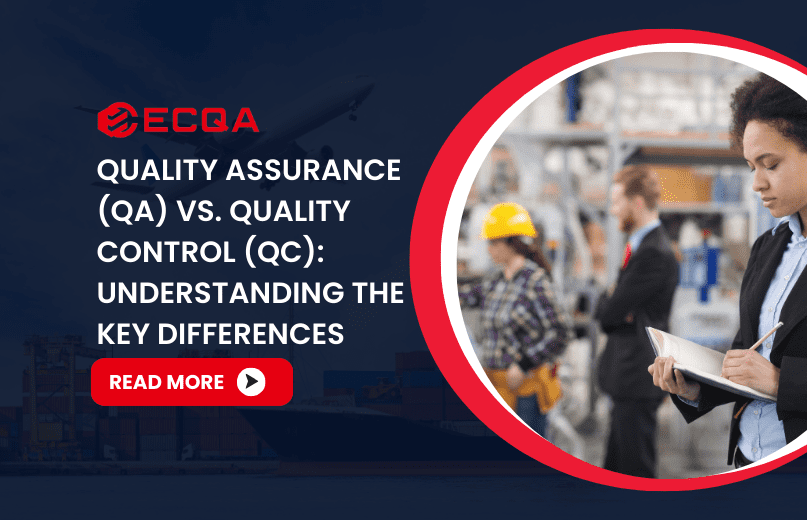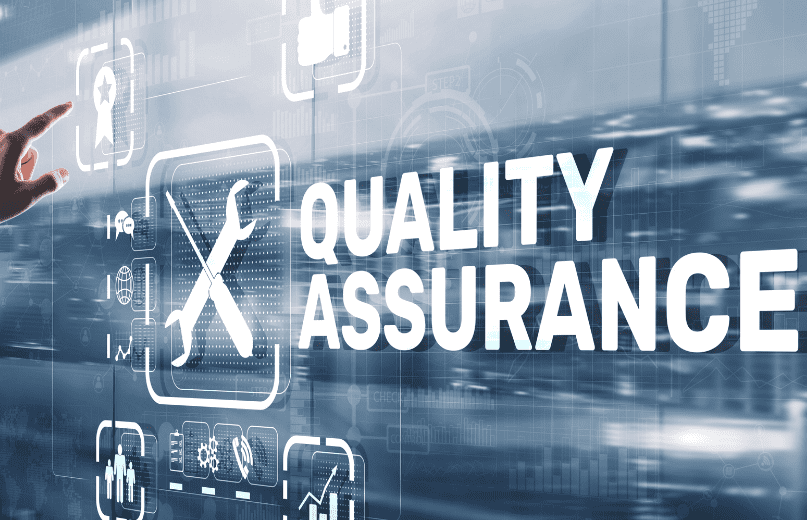
Quality Assurance vs. Quality Control
The terms Quality Assurance (QA) and Quality Control (QC) are often confused, yet they perform distinct functions within a company’s quality management system (QMS). Understanding their differences is essential for maintaining consistent quality, meeting regulatory standards, and improving customer satisfaction.
Quality Assurance focuses on preventing defects by controlling and improving processes, while Quality Control focuses on detecting and correcting defects through inspection and testing. Together, they form the foundation of an effective quality management system. QA ensures that processes consistently produce quality outcomes, and QC verifies that the final product meets all defined requirements.

What is Quality Assurance (QA)
Quality Assurance is a structured process focused on preventing errors and ensuring that operations consistently meet predetermined standards. It emphasizes systematic planning, process design, and continuous improvement rather than end-stage inspection.
In short, QA ensures the right process is in place to create a quality product.
Role in a Quality Management System
Within frameworks such as ISO 9001, QA defines how processes are established, monitored, and improved. It sets the foundation for training, documentation, and audits, ensuring that everyone follows standardized procedures throughout production or service delivery.
Core QA Activities
- Creating and maintaining Standard Operating Procedures (SOPs)
- Conducting internal audits to verify compliance
- Developing training programs for production and quality teams
- Performing risk assessments and root-cause analyses
- Establishing continuous improvement initiatives using Lean or Six Sigma
Prevention-Focused Philosophy
The core of QA is prevention. Rather than fixing problems later, QA identifies potential weaknesses before they cause defects.
For example, during a pre-production inspection, materials and processes can be reviewed to ensure they meet all technical and safety requirements before mass production begins.
Benefits of Quality Assurance
- Fewer production errors and lower rework costs
- Consistent compliance with regulations and standards
- Faster production cycles through streamlined processes
- Higher overall customer satisfaction and trust
- Stronger internal communication and accountability

What is Quality Control (QC)
Quality Control refers to the set of operational techniques and activities used to identify and correct defects in the finished product. It verifies whether the outcome of the process meets specified standards.
QC focuses on checking and validating that products perform as expected, function safely, and meet customer requirements.
Role in Product Inspection and Testing
QC ensures that products leaving the production line are compliant with defined specifications.
In manufacturing, inspectors evaluate product dimensions, visual appearance, and performance.
In electronics, QC involves durability and safety tests, while in food production, it may include microbiological and packaging checks.
For consumer goods, QC is often conducted through pre-shipment inspection, ensuring that only conforming products reach customers.
Common QC Methods and Tools
- Visual inspection: Detecting cosmetic or assembly defects
- Sampling based on AQL standards: Evaluating a representative quantity to infer batch quality (see Free AQL Table eBook)
- Functional and performance testing
- Statistical Process Control (SPC) charts to track variation
- Verification and validation activities
- Instrument calibration to maintain measurement accuracy
Detection-Focused Philosophy
QC is reactive as it identifies issues after production and corrects them before release.
For instance, if testing reveals deviations, corrective actions might include process adjustment, component replacement, or full batch rejection.
Benefits of Quality Control
- Ensures consistency and reliability of finished goods
- Reduces the likelihood of product recalls or complaints
- Improves compliance with regulatory and customer specifications
- Detects issues early, minimizing downstream losses
- Strengthens product credibility and safety assurance
Key Differences Between Quality Assurance and Quality Control
| Category | Quality Assurance (QA) | Quality Control (QC) |
| Focus | Processes and systems | Final products and outcomes |
| Approach | Preventive | Corrective |
| Objective | Prevent defects through process improvement | Identify and fix defects through inspection |
| Timing | Before and during production | After production |
| Responsibility | Quality engineers, management, and planners | Inspectors, testers, and operators |
| Methods | Audits, SOPs, training, process mapping | Sampling, testing, measurement |
| Goal | Build quality into the process | Verify quality in the result |
Although QA and QC differ in focus, they complement each other. QA establishes a system that ensures consistency, while QC validates the system’s output.
How QA and QC Work Together
While QA prevents problems and QC detects them, both are interconnected.
An effective quality management strategy uses QA to create reliable processes and QC to monitor their effectiveness.Information gathered from QC inspections feeds back into QA systems to drive continual improvement.
Example of Integration
- Before production: QA teams create standardized processes and verify raw materials.
- During production: QC inspectors monitor samples to ensure consistency.
- After production: Results from QC feed into QA reports for future preventive measures.
This cycle of prevention, detection, and correction forms the backbone of a high-performing quality system.
Applications Across Industries
1. Manufacturing
QA ensures equipment calibration, operator training, and supplier quality, while QC confirms that the final goods meet design and performance specifications.
2. Electronics and Electrical Products
QA manages compliance with safety standards such as CE or UL, whereas QC validates electrical performance and product durability.
Learn more about product testing and certification.
3. Textiles and Apparel
QA defines inspection checkpoints and fabric standards, while QC examines colorfastness, stitching accuracy, and packaging quality.
4. Food and Consumer Goods
QA handles hygiene standards and process control, while QC inspects labeling accuracy, packaging integrity, and shelf-life tests.
5. Software and Digital Products
QA establishes coding standards and version control procedures; QC performs functional and usability testing before deployment.
Common Challenges in QA and QC
1. Communication Gaps
Misalignment between QA and QC teams can cause redundant tasks or missed issues. Clear documentation and shared metrics resolve most gaps.
2. Resource Constraints
Effective QA/QC requires skilled personnel, calibrated tools, and adequate time allocation. Under-resourced teams often struggle to maintain quality consistency.
3. Inconsistent Standards
Different facilities or regions might apply varying criteria. A unified QMS and standardized audits ensure alignment.
4. Data Utilization
Many organizations collect inspection data but fail to analyze it for trends. Implementing digital tracking systems helps transform data into actionable improvement insights.
5. Resistance to Change
Introducing new quality systems often meets resistance. Ongoing training and management support are critical for adoption.
Best Practices for a Unified QA and QC System
- Establish a documented Quality Management System (QMS) aligned with ISO 9001 principles
- Implement regular internal audits to ensure adherence
- Use digital inspection data for real-time analysis
- Standardize checklists and acceptance criteria across sites
- Provide continuous training on process control and product testing
- Conduct periodic supplier audits to strengthen upstream quality
- Apply a feedback loop where QC results inform QA process updates
Together, these steps create a balance between prevention and detection—ensuring sustained quality improvement.
The Importance of QA and QC in Global Supply Chains
Modern supply chains rely on collaboration across multiple factories, suppliers, and testing partners.
QA ensures that each supplier follows approved processes, while QC confirms that every shipment meets the buyer’s expectations.
This two-layered approach minimizes quality risks and helps businesses meet the growing complexity of international regulations and consumer expectations.
For further reading, explore related resources:
- Product Compliance vs Product Certification
- Top 10 Quality Inspection Mistakes
- How to Verify Supplier Claims on Recycled Materials
Quality Assurance and Quality Control are two sides of the same objective: ensuring products and services meet expectations.QA builds quality into the process; QC verifies quality in the final outcome.
When implemented together within a structured QMS, they create a cycle of prevention, detection, and continuous improvement such as reducing risks, maintaining compliance, and delivering consistent value to customers.
Frequently Asked Questions about Quality Assurance and Quality Control.
1. What is the main difference between Quality Assurance and Quality Control?
Quality Assurance focuses on preventing defects by improving and standardizing processes, while Quality Control focuses on detecting defects through inspection and testing.
2. Why is Quality Assurance important?
QA reduces production errors, ensures compliance with standards, and builds consistency throughout operations. It forms the foundation for reliable manufacturing and service delivery.
3. What does Quality Control involve?
QC involves inspecting, testing, and verifying that finished products meet all specifications before shipment. It ensures that customers receive only conforming products.
4. How do QA and QC complement each other?
QA designs processes to produce quality outcomes, and QC confirms those outcomes meet expectations. Data from QC helps QA refine future processes.
5. . Which comes first: QA or QC?
QA activities occur throughout process design and production, while QC follows as a verification step once products are completed.
6. What tools are used in QA and QC?
Common QA tools include process maps and root-cause analysis, while QC tools include sampling plans, control charts, and inspection checklists.
7. Are QA and QC required for all industries?
Yes. Whether in manufacturing, technology, or healthcare, QA ensures process discipline, and QC ensures product reliability. Both are core elements of modern quality management.

 Request Free Sample Report
Request Free Sample Report